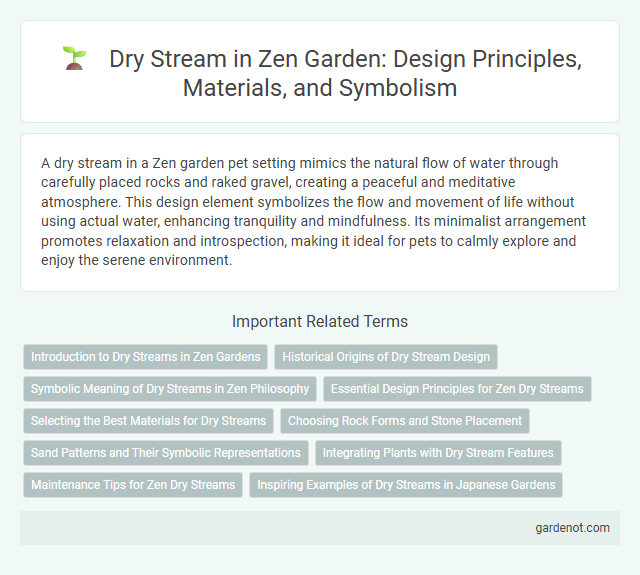A dry stream in a Zen garden pet setting mimics the natural flow of water through carefully placed rocks and raked gravel, creating a peaceful and meditative atmosphere. This design element symbolizes the flow and movement of life without using actual water, enhancing tranquility and mindfulness. Its minimalist arrangement promotes relaxation and introspection, making it ideal for pets to calmly explore and enjoy the serene environment.
Introduction to Dry Streams in Zen Gardens
Dry streams, or "kare-sawa," are a fundamental element in Zen gardens, representing flowing water using carefully arranged rocks and gravel. These features symbolize natural waterways, enhancing the garden's aesthetic and meditative qualities through minimalist design. Incorporating dry streams encourages mindfulness by evoking the tranquil movement of water without its physical presence.
Historical Origins of Dry Stream Design
The dry stream design, also known as karetaki or kare-sawa, originated in Japan during the Muromachi period (1336-1573) as an integral element of Zen gardens. This technique simulates flowing water using gravel, rocks, and sand to evoke tranquility and the natural rhythm of rivers without actual water. Rooted in Zen Buddhism, dry streams represent the fluidity of existence and the impermanence emphasized in traditional Japanese aesthetics.
Symbolic Meaning of Dry Streams in Zen Philosophy
Dry streams in Zen gardens symbolize the flow of life and the impermanence of existence, representing water without actual fluid. This feature reflects the Zen concept of emptiness (sunyata) and encourages mindfulness by illustrating tranquility and continuity amid change. These symbolic dry streams foster meditation on nature's rhythms, embodying simplicity and spiritual depth central to Zen philosophy.
Essential Design Principles for Zen Dry Streams
Zen dry streams, or karesansui, embody simplicity and natural flow through carefully arranged rocks and gravel. Essential design principles include asymmetry to mimic organic water movement, layered textures for depth, and the strategic placement of stones to suggest a riverbed winding through the landscape. Meticulous raking patterns enhance the illusion of flowing water, creating a tranquil and contemplative space.
Selecting the Best Materials for Dry Streams
Choosing the best materials for dry streams in Zen gardens involves selecting smooth river rocks, gravel, and sand to mimic natural water flow and texture. Incorporating a variety of sizes and colors enhances visual interest while promoting the tranquil aesthetic typical of traditional Japanese dry landscapes. Proper material selection ensures durability, low maintenance, and authentic representation of flowing water in the garden.
Choosing Rock Forms and Stone Placement
Selecting rock forms in a Zen garden's dry stream involves prioritizing natural shapes that evoke the flow of water, such as elongated and smooth stones. Stone placement should create a sense of movement and harmony, with larger rocks positioned strategically to mimic river bends and smaller pebbles scattered to represent ripples. The arrangement must balance asymmetry and simplicity, promoting tranquility and guiding the viewer's eye along the imagined stream path.
Sand Patterns and Their Symbolic Representations
Sand patterns in Zen garden dry streams symbolize the flow of water and natural movement, often crafted with meticulous raking techniques to evoke ripples and currents. These patterns represent tranquility, impermanence, and the passage of time, reflecting Zen principles of mindfulness and simplicity. The undulating lines mimic rivers or ocean waves, guiding contemplation and enhancing the garden's meditative atmosphere.
Integrating Plants with Dry Stream Features
Integrating plants with dry stream features enhances the natural aesthetic and promotes ecological balance in a Zen garden. Selecting drought-tolerant grasses, succulents, and mosses along the edges of the dry stream bed creates visual contrast and softens the rocky terrain. This strategic planting also helps prevent soil erosion and supports habitat diversity while maintaining the minimalist principles of Zen design.
Maintenance Tips for Zen Dry Streams
Maintaining a Zen dry stream requires regular raking to preserve the carefully arranged gravel patterns and prevent debris accumulation. Replenishing gravel or sand ensures the stream retains its clean, flowing appearance, while trimming surrounding plants prevents overgrowth from disrupting the minimalist design. Monitoring moisture levels helps avoid weed growth and maintains the garden's serene, low-maintenance aesthetic.
Inspiring Examples of Dry Streams in Japanese Gardens
Dry streams, or karesansui, exemplify minimalist beauty in Japanese gardens by mimicking flowing water through carefully arranged rocks and gravel. Renowned examples like the Ryoan-ji garden in Kyoto showcase intricate patterns of raked gravel symbolizing rippling water, creating serene landscapes for meditation. These dry streams highlight the aesthetic principles of simplicity and natural harmony central to Zen garden design.
Dry stream Infographic

 gardenot.com
gardenot.com